

The Impact Of Overfishing On Fish Population: The Concept Of Overfishing, Types Of Overfishing & How Do We Know Overfishing Takes Place? Parven.
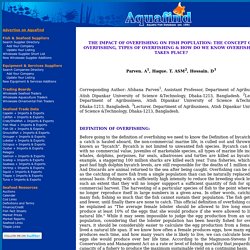
A1, Haque. T. Overfishing. Fishing is one of the most significant drivers of declines in ocean wildlife populations.
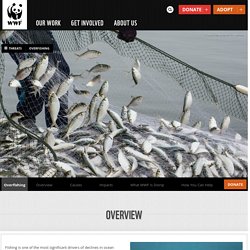
Catching fish is not inherently bad for the ocean, except for when vessels catch fish faster than stocks can replenish, something called overfishing. The number of overfished stocks globally has tripled in half a century and today fully one-third of the world's assessed fisheries are currently pushed beyond their biological limits, according to the Food and Agriculture Organization of the United Nations.
Whaling Information and Whale Hunting Facts. Whaling is cruel and the demand for whale meat is falling.
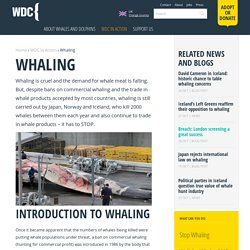
But, despite bans on commercial whaling and the trade in whale products accepted by most countries, whaling is still carried out by Japan, Norway and Iceland, who kill 2000 whales between them each year and also continue to trade in whale products – it has to STOP. Once it became apparent that the numbers of whales being killed were putting whale populations under threat, a ban on commercial whaling (hunting for commercial profit) was introduced in 1986 by the body that regulates whaling – the International Whaling Commission. However, over 30,000 whales have been killed since the ban came into effect because of loopholes that have allowed some countries to carry on whaling. The International Whaling Commission currently allows Norway to hunt under an ‘objection’ to the ban, and Japan uses a loophole which allows countries to hunt whales for ‘research purposes’.
Frequently asked questions about whaling. Why You Should Care About the Ocean.
One Year Later: Reflecting on Slaughter of Bottlenose Superpod and Capture of Albino Calf, Shoujo. January 16, 2015 Images Taken by Sea Shepherd’s Cove Guardians, Documenting the Brutal Capture of “Shoujo” and Horrific Slaughter of Her Family, Sparked an International Media Firestorm Baby albino dolphin, Shoujo, clings to her mother in the cove Photo: Sea ShepherdAs the one-year anniversary of the unprecedented capture of more than 250 bottlenose dolphins and a rare albino calf in Taiji approaches, Sea Shepherd Conservation Society is reflecting upon this horrific event that drew worldwide media, public and political scrutiny to the annual capture and slaughter of dolphins and small whales in the cove.
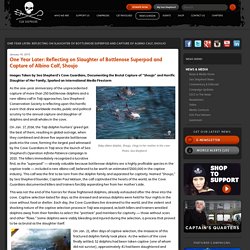
15 ways to save our ocean! 1.
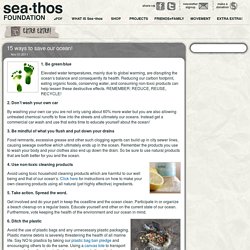
Be green/blue Elevated water temperatures, mainly due to global warming, are disrupting the ocean’s balance and consequently its health. Reducing our carbon footprint, eating organic foods, conserving water, and consuming non-toxic products can help lessen these destructive effects. REMEMBER: REDUCE, REUSE, RECYCLE! 2. By washing your own car you are not only using about 60% more water but you are also allowing untreated chemical runoffs to flow into the streets and ultimately our oceans. 3.
Endangered and Threatened Marine Species. Marine Mammals (27 listed "species") Manatees and sea otters are also listed under the ESA, but fall under the jurisdiction of the U.S.
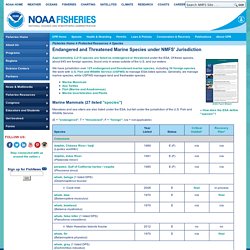
Fish and Wildlife Service. (E = "endangered"; T = "threatened"; F = "foreign"; n/a = not applicable) Sea Turtles (16 listed "species") ^ These populations were listed before the 1978 ESA amendments that restricted population listings to "distinct population segments of vertebrate species. " Fish (Marine & Anadromous) (57 listed "species") (E = "endangered"; T = "threatened"; F = "foreign"; XN = "nonessential experimental population"; n/a = not applicable) ** All Pacific salmonid listings were revisited in 2005 and 2006.
Marine Invertebrates (24 listed "species") Marine Plants (1 listed "species") * NOTE: Critical habitat cannot be designated in foreign waters; critical habitat is also not required for species listed prior to the 1978 ESA amendments that added critical habitat provisions. Polaraction.pdf. Five Reasons We are All Connected to Oceans. Peanut butter, every other breath you take, cancer medicine and one in six jobs in the United States.
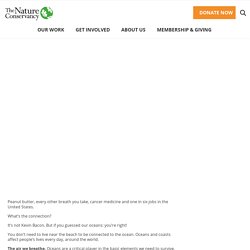
What’s the connection? It’s not Kevin Bacon. But if you guessed our oceans: you’re right! Why we protect our oceans. Why protect our oceans?
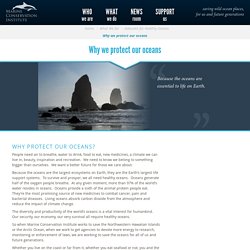
People need air to breathe, water to drink, food to eat, new medicines, a climate we can live in, beauty, inspiration and recreation. We need to know we belong to something bigger than ourselves. We want a better future for those we care about. Because the oceans are the largest ecosystems on Earth, they are the Earth’s largest life support systems. Protecting the Ocean. World’s Largest Single Marine Reserve Created in Pacific The area around the Pitcairn Islands is one of the most pristine places on Earth.
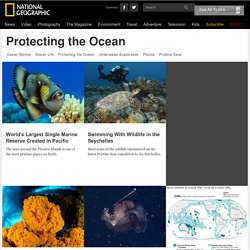
Swimming With Wildlife in the Seychelles Meet some of the wildlife enountered on the latest Pristine Seas expedition to the Seychelles. Value passed to resize filter must be a valid URL. Gabon Unveils Huge Marine Reserve The protected area will cover 18,000 square miles of ocean—home to great hammerhead sharks, manta rays, whale sharks, and tiger sharks. Watch: Rare Sea Devil Fish Caught Made famous in the movie Finding Nemo, a sea devil is caught on film for the first time. Why Should We Care About the Oceans?